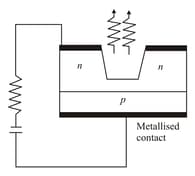Extrinsic Semiconductors
Extrinsic Semiconductors: Overview
This topic covers concepts, such as pentavalent impurities, trivalent impurities, doping, n-type semiconductor, and p-type semiconductor.
Important Questions on Extrinsic Semiconductors
In a -type semiconductor, which of the following statement is true?
For a pure Si crystal has atom $\mathrm{m}^{-3}$. It is doped by PPM concentration of pentavalent As. Calculate the number of electron & holes.
(Given that )
In a pure semiconductor crystal of , if antimony is added then what type of extrinsic semiconductor is obtained. Draw the energy band diagram of this extrinsic semiconductor so formed.
When an intrinsic semiconductor such as is doped with a small amount of a trivalent impurity like boron
The base region of a silicon n-p-n transistor is obtained by doping with either
The Fermi level for an extrinsic ‘n’ type semiconductor:
To obtain electrons as majority charge carriers in a semiconductor the impurity mixed is
Why is an extrinsic semiconductor electrically neutral
Why are n-type and p-type semiconductor electrically neutral
Explain the charge neutrality of Extrinsic Semiconductors
What are minority current carriers in Extrinsic semiconductor.
Which of the following energy band diagram shows the N-type semiconductor
In -type semiconductor, Silicon is doped with
What is type of majority charge carriers present in p-type semiconductor?
No crystal is found to be prefect at room temperature. The defects present in the crystals can be stoichiometric or non-stoichiometric. Due to nonstoichiometric defects, the formula of the ionic compound is different from the ideal formula. For example, the ideal formula of ferrous oxide should be but actually in one sample, it was found to be . This is because the crystal may have some ferric ions in place of ferrous ions. These defects change the properties of the crystals. In some cases, defects are introduced to have crystals of desired properties as required in the field of electronics. Doping of elements of Group 14 with those of Group 13 or 15 is most common. In ionic compounds, usually impurities are introduced in which the cation has higher valency than the cation of the parent crystal, e.g., into .
Which one of the following doping will produce p-type semiconductor ?
Holes are majority carriers in n-type semiconductor while electrons are majority carries in p-type semiconductor.
A P-type semiconductor has more holes than electrons.
The hole density and electron density in -type semiconductors are related as

